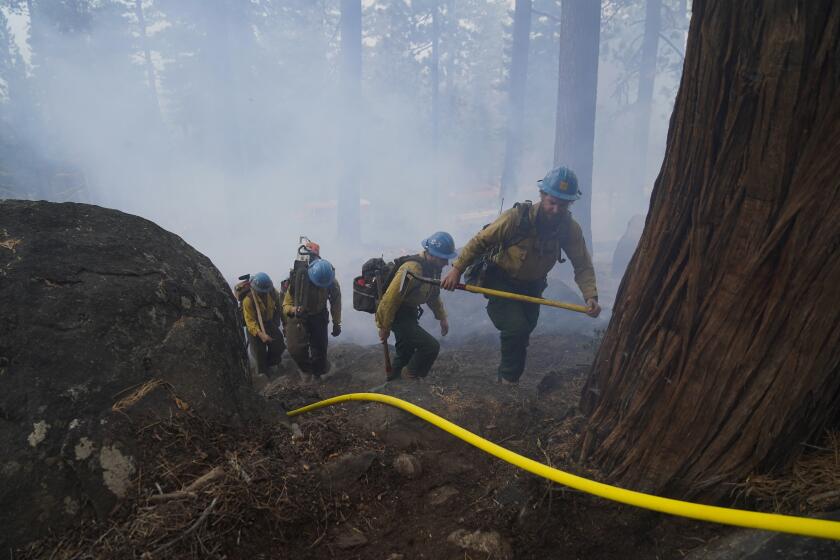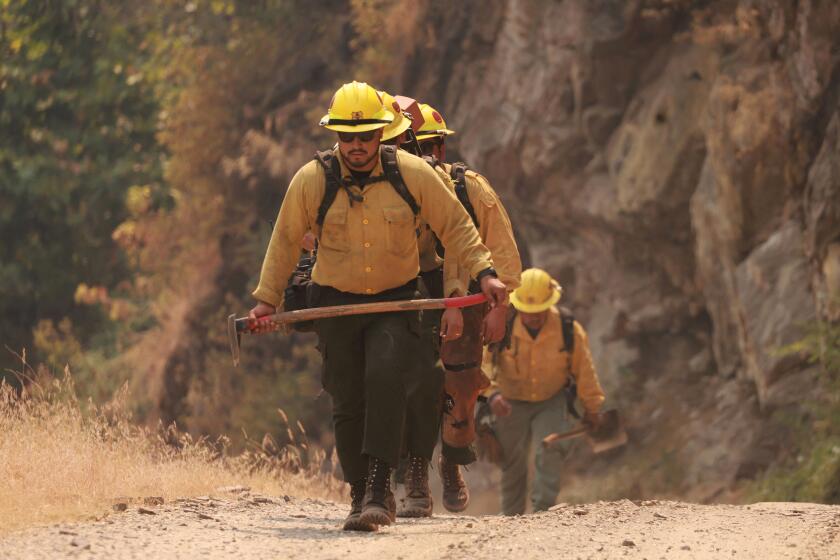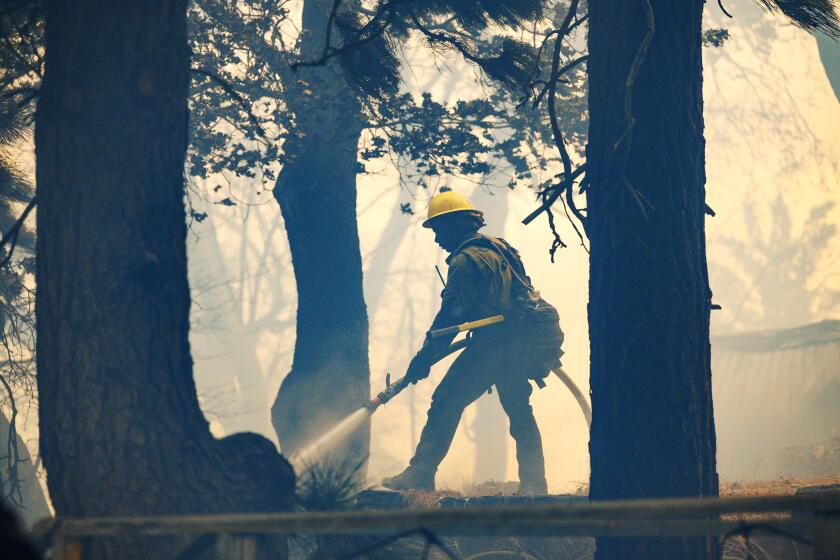
- Share via
On a scorching September afternoon, an Orange County public works crew moving boulders with heavy machinery sparked a brush fire. The blaze ignited less than two miles from the U.S. Forest Service’s Trabuco Station, but the station was unstaffed by federal firefighters. The only crew there was the Orange County Fire Authority’s Engine 18.
When that engine arrived on scene, the fire was just half an acre, burning in medium brush with a moderate rate of spread, according to radio communications provided by Orange County Fire Chief Brian Fennessy. The crew also encountered two people who required treatment for smoke inhalation, he said.
Fennessy wonders whether, had a Forest Service engine responded with them, the firefighters could have contained the flames to the grassy flats. Instead, the fire raced up steep slopes into forested areas, growing into a 23,000-acre behemoth that destroyed 160 structures and injured 22 people.
“There’s no question in my mind that two engines would have made a difference,” he said.

The Airport fire was the latest example of how Forest Service staffing shortages have hindered firefighting efforts, putting public safety at risk, according to Fennessy and other Southern California fire chiefs. They say that many of the region’s Forest Service stations have gone unstaffed in recent years, putting more pressure on state and municipal firefighting agencies to fill in gaps.
“The Southern California fire chiefs do believe strongly that this is affecting our local communities,” said San Bernardino County Fire Chief Dan Munsey, who together with Fennessy and other fire chiefs took their concerns to Forest Service Region 5 Director Jaime Gamboa at a meeting in Lake Arrowhead in July. The issues remain unresolved, they said.
Five U.S. congressional representatives from Southern California recently sent a letter to the Cleveland National Forest demanding answers about how officials are dealing with its staffing challenges, saying they believe those shortages likely contributed to the outcome of the Airport fire.
A letter from five U.S. Congress members demands answers on staffing shortages in the Cleveland National Forest.
The Forest Service disputed claims by the county fire chiefs, saying the agency is meeting its obligations to respond to emergencies and protect lives and properties.
Adrienne Freeman, a spokesperson for the agency, acknowledged that the Trabuco Station wasn’t staffed by federal firefighters when the fire broke out, but said other engines were positioned nearby to backfill that gap.
The Forest Service has regularly maintained full staffing levels in Southern California this summer by bringing in resources from other regions and out of state to fill in for engine companies that are unavailable, and daily reports cited by the fire chiefs that list Forest Service stations as unstaffed don’t necessarily reflect those “surge resources,” she said.
She also noted that the Airport fire was the third large blaze to break out within a 40-mile radius in Southern California in four days, on the heels of the Line fire near the San Bernardino National Forest and the Bridge fire in the Angeles National Forest.
“With three major fires starting in that close time frame and a finite number of firefighters across the board, you’re going to have a lot of unavailable engines,” she said.

Still, she said, the Forest Service’s response to the Airport fire was “robust and appropriate.” Computer-aided dispatch records show the agency sent three engines, one water tender, a fire patrol, a chief officer and aircraft within minutes of receiving the request for mutual aid, she said. And modeling from the California Office of Emergency Services illustrated that the conditions were conducive to rapid fire spread, she added.
“It’s highly speculative to say that one engine would have made a difference,” she said.
Orange County retains law firm as attorneys begin a coordinated effort to file potentially hundreds of claims from victims of the Airport fire.
Tactical disputes between the Forest Service and local firefighting agencies are nothing new. In the wake of the 2009 Station fire, then the largest in Los Angeles County, the Forest Service was found to have been slow to order reinforcements from other agencies in a bid to control costs. That drew finger-pointing from federal officials, who said they did everything they could to get aircraft to the scene as soon as possible, and state and local agencies, who said they had aircraft at the ready that were never ordered.
During California’s devastating 2021 fire season, several state and local fire officials spoke out against a Forest Service policy of allowing some fires to burn naturally in certain areas before suppressing them.
The staffing shortages are the latest issue to bring these long-simmering tensions to the forefront. Federal firefighters face grueling conditions that have grown more harrowing in part due to climate change. They are generally much lower paid than their counterparts at state and municipal agencies, utilities and private companies. The Forest Service has suffered an exodus of firefighters in recent years, many of them mid-career professionals such as captains and engine bosses who took with them decades of institutional knowledge that can’t easily be replaced.

The problem is particularly acute in Southern California, where fires tend to be extraordinarily complex and the cost of living high, especially in and around national forests that typically house resort communities. Unionized employees at the California Department of Forestry and Fire Protection are currently considering a new labor contract that would reduce their workweek from 72 to 66 hours, which is expected to touch off a fresh hiring spree that may result in even more attrition from the Forest Service.
Advocates have for years been warning that this hemorrhaging of skilled federal firefighters, who remain the nation’s premier experts on battling wildland fires, threatens to compromise public safety. They have long been pushing for Congress to pass comprehensive reform, including permanent salary increases, housing stipends and expanded mental health programs.
Since 2021, legislators have passed a series of measures temporarily boosting wildland firefighter pay, but those bonuses have not counted toward overtime, hazard pay and retirement benefits.
“Meanwhile, we have our federal wildland fire workforce losing faith in Congress and the federal government and the agency, and they’re walking,” said Max Alonzo, national business representative for the National Federation of Federal Employees. “They are going pretty much anywhere else. So it’s a bad situation on the ground.”
A federal firefighter’s viral resignation letter is highlighting the job’s low pay and harsh working conditions in the age of climate change.
The shortages have resulted in Forest Service stations in Southern California sitting empty because there is no one to supervise them, according to the fire chiefs. Fennessy shared a staffing report from the morning of Sept. 9, when the Airport fire started, that listed 14 of the Cleveland National Forest’s 28 engines as unavailable and another report showing the Trabuco Station was unstaffed by federal firefighters for the first two weeks of the month. He described those staffing levels as typical.
Of the roughly 25 Forest Service stations in San Bernardino County, only 11 or so are staffed at any given time, at best, Munsey said.
“My belief is they are no longer adequately covering their fire stations on a daily basis,” he said. “They are losing the experience that is required to manage large incidents. Because of this, they’re putting a greater burden on local taxpayers, and on city and county fire engines who must now pick up the slack to protect our communities.”
One exception is the Angeles National Forest, which has robust year-round staffing, officials said. “I haven’t had those challenges that the other municipal fire chiefs have had to deal with, like, ‘Hey, where’s the Forest Service?’” said Los Angeles County Fire Chief Anthony Marrone.
Still, Forest Service firefighters typically deal only with wildfires and related land management activities. Local firefighting agencies have long handled other types of emergencies on federal lands, including traffic accidents, medical calls and structure fires. Over the last five years, the fire agencies of Kern, Los Angeles, Orange, San Bernardino and Ventura counties have together responded to, on average, 11,263 incidents on federal lands each year, according to figures compiled by Munsey.
The majority of those calls have been handled by San Bernardino County Fire, which has responded to federal lands an average of 8,529 times a year over the last five years, he said. These services come at an annual cost to county taxpayers of roughly $14 million, and the Fire Department receives no reimbursement from the federal government, he said.

Although wildland fires are a relatively small share of those incidents, they represent a growing burden that has resulted in more and longer responses in federal jurisdictions, Munsey said. Because many Forest Service stations are staffed only during the day and during fire season, local agencies that share borders with national forests are often the first to respond to wildland fires at night and during the offseason.
For instance, when a fire ignited atop Santiago Peak in the Cleveland National Forest one night in August 2023, it took the first Forest Service engine nearly three hours to arrive, leaving the initial response to Orange and Riverside counties, Fennessy said.
“Local government is the largest provider of mutual aid resources in the state of California,” he said. “So when an agency like the Forest Service is not able to staff fully statewide in this region, the resources to put out these fires, even if it’s a Forest Service fire in the federal responsibility area, defaults to local government.”
A prolonged heat wave across much of the western U.S. is challenging wildland firefighters, with an uptick in heat-related illnesses reported in California.
That has also at times meant that fewer local firefighters were available to respond to other emergencies. The events earlier this month, when the Line, Bridge and Airport fires raged simultaneously, represented a nightmare scenario.
“There was nobody in the mutual aid system,” Munsey said. “So on the Bridge fire, as it approached Mt. Baldy and Wrightwood, that forced me to make the decision to empty almost every single one of our fire stations into those communities to stop the fire.”
“We literally had nobody covering our fire stations,” he added. “That is not a position that a fire chief should ever be in.”
Both Munsey and Fennessy were critical of the Forest Service’s practice of bringing in firefighters from out of state to backfill unstaffed positions, saying they lack experience with California’s terrain, interagency agreements and operating procedures.
They believe that, if the Forest Service is unable to hire enough California firefighters to staff its stations, the agency should contract them out to local fire authorities instead. Twice this year, Fennessy met with Cleveland National Forest Supervisor Scott Tangenberg offering to assist, at one point saying that he’d staff the stations at no cost to the Forest Service.
Running Springs, a mountain town that dealt with a deadly blizzard last year, is now contending with the raging Line fire. But some residents are staying put.
Freeman, of the Forest Service, said that “everybody was strapped” when the three large fires hit — the mutual aid system was strained by their geographical proximity, complexity and sheer size, not federal staffing shortages.
She defended the practice of bringing in firefighters from out of state, saying that it allows the agency to avoid depleting local resources by pulling them from places with less fire activity.
Munsey has been pressing the need to address the federal staffing shortages during meetings with members of Congress for several years. He and other Southern California fire chiefs also met in April with representatives of the U.S. Fire Administration. He said that athough federal lawmakers who represent California are supportive, it’s hard to get a coalition to take up the issue because it’s not affecting the entire country.
He said that one recent anecdote brings the problem into sharp relief: During the Line fire, the Forest Service’s initial attack incident commander had to turn over his duties and position to someone else. He had to go take a medical exam because he was leaving the agency to work for Cal Fire.











